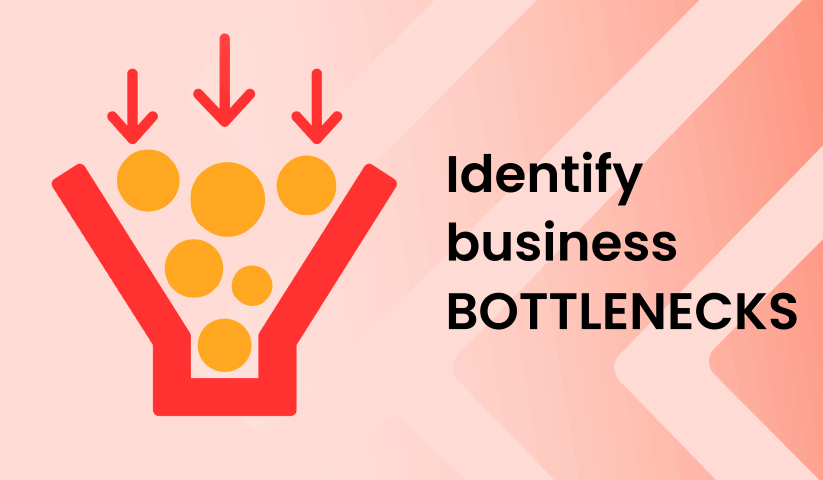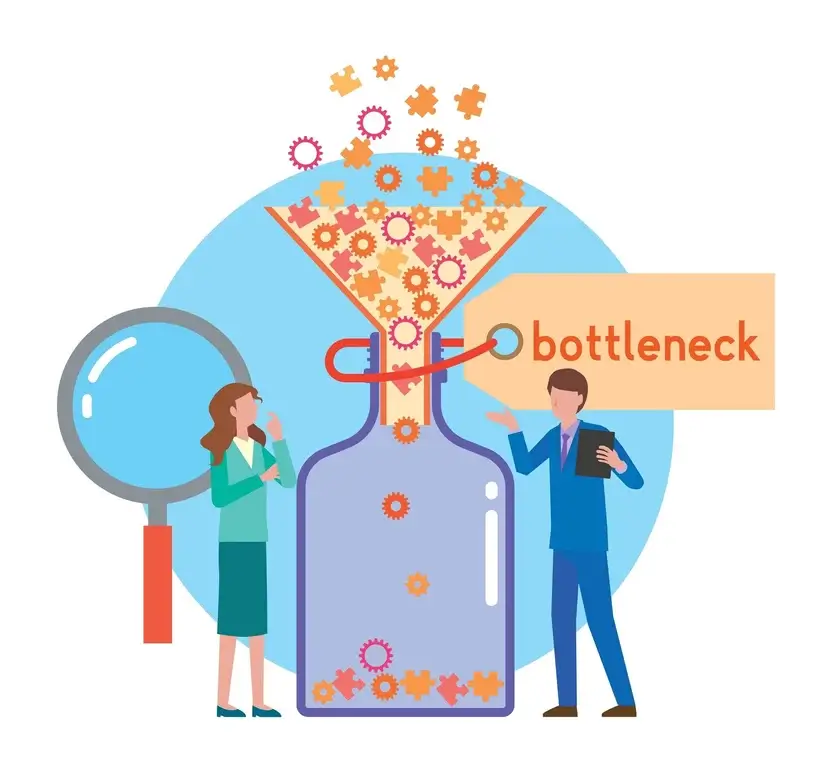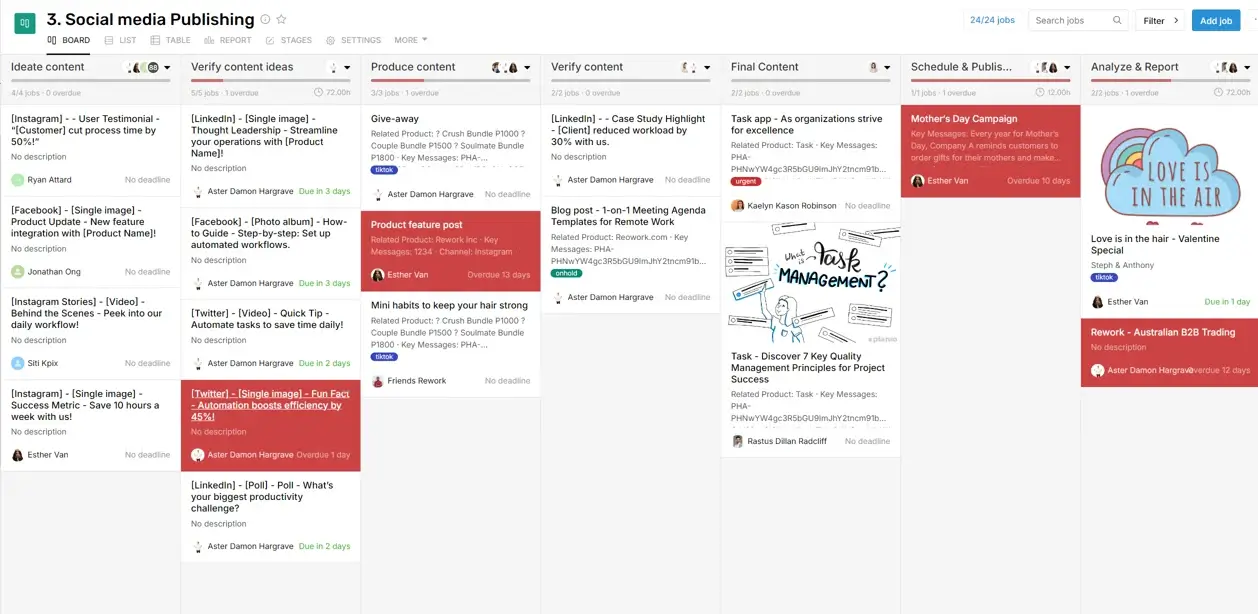Process Management
How to identify the bottleneck blocking your business workflows?

How many business processes are currently running in your company? How many of them ensure that inputs and outputs are as precise and efficient as if handled by a machine? Or do you still get complaints from everyone involved?
Your partners may complain about delayed contracts, customers might express frustration at the lack of timely responses, and orders still fall behind schedule despite increasing manpower.
Processes that look flawless on paper often hit snags when implemented in real life. It’s like a road that suddenly gets clogged. Somewhere along the line, traffic is no longer moving smoothly. But what’s happening? How can you quickly and accurately identify the problem area to resolve it once and for all?
What is a bottleneck in business?
The term "bottleneck" comes from the idea of trying to pour marbles out of a bottle with a narrow neck. In an ideal scenario, the marbles should easily roll out since their diameter is smaller than the neck of the bottle, as long as the bottle is tilted downward. However, in reality, things aren't that simple. Several marbles often gather at the narrow neck at the same time, blocking each other and preventing smooth flow. This is what we refer to as a bottleneck or process blockage.
 The concept of a "bottleneck" often brings to mind an output blockage
The concept of a "bottleneck" often brings to mind an output blockage
By basic definition, a bottleneck is a point within a business process where the volume of tasks exceeds the maximum throughput capacity, causing workflow interruptions, delays, or congestion.
A bottleneck occurs when too many tasks attempt to pass through a resource-constrained area. A business process may contain more than one bottleneck. The bottleneck of one process could also be the choke point of another. Unfortunately, bottlenecks are often only recognized and acknowledged after they’ve caused significant delays.
Examples of bottlenecks in business
Bottlenecks can be spotted most easily in manufacturing processes. For example, in a candy production line, 1000 pieces are produced daily. Still, the packaging department can only handle 600 pieces, 60% of the target production, causing the boxing stage to fall short on inputs.
However, every business process in your company is susceptible to bottlenecks, and many of them likely encounter bottlenecks early in their development stages.
A bottleneck can refer to any resource, whether tangible or intangible, within your business, or even external factors. For example:
- A manual, cumbersome document processing system
- An outdated policy that no longer complies with new legal regulations
- A micromanagement mindset that stifles creativity
- A delivery truck that constantly needs repairs
- A new employee still unfamiliar with their role
- An employee providing incorrect information, requiring time to fix it
- A manager too busy to approve reports
- A team that lacks effective collaboration, leaving tasks unassigned
- A job applicant who delays email responses during the hiring process
- ...
Different types of bottlenecks in business
In terms of duration, there are two types of business bottlenecks:
- Short-term bottlenecks: These are caused by unexpected and temporary issues. For example, if a key team member falls ill and takes a three-day leave, and no one else can fill in for them, the work will pile up until they return.
- Long-term bottlenecks: These are recurring, unresolved issues that persist over a longer period. For instance, in a media company, there may be five productive video editors, but only one person is responsible for content approval, resulting in final products consistently being delayed beyond the planned deadlines.
In terms of causes, there are four types of bottlenecks:
- System bottlenecks: These occur when a limitation in the software or technology used by a business slows down operations. For example, a company might have outdated inventory management software that struggles to handle increased demand, causing delays in order fulfillment.
- Process bottlenecks: These happen when inefficiencies or roadblocks within a workflow or procedure slow down progress. For instance, a manufacturing company may have a cumbersome approval process for design changes, leading to production delays and missed deadlines.
- People bottlenecks: These arise when the availability or capacity of employees becomes a constraint. For example, a project team may rely on one highly specialized engineer for critical tasks, causing delays whenever that person is unavailable or overworked.
- Production bottlenecks: These occur when the physical production process is unable to keep up with demand. For instance, a factory may have enough orders to increase output, but its production line is limited by the speed of a single machine, slowing down the entire process.
Why is it important to identify bottlenecks as early as possible?
Bottlenecks do not affect a standalone stage but the whole process, which means they have the potential to cause widespread damage, affecting many other crucial areas. Identifying them quickly and accurately is like diagnosing and treating an illness in the body to restore health. Detecting bottlenecks early helps prevent further complications, ensuring smoother operations and improved overall performance.
A bottleneck in business processes can lead to:
- Increased costs and reduced revenue due to delays and inefficiencies.
- Missed opportunities and competitive advantages from work progress delays.
- Lower productivity, missed output targets, and customer dissatisfaction.
- Unbalanced workloads as whether too slow or too overwhelmed, causing employee frustration.
- Poor planning and resource allocation, leading to internal conflicts and blame-shifting culture.
 Bottlenecks in business are similar to traffic congestion
Bottlenecks in business are similar to traffic congestion
Most metrics for evaluating the success of a business process revolve around cost, quality, and time, and the balance between these three factors.
If your main goal is quality (e.g., product design process), a bottleneck might not be the top concern. If cost optimization is your focus (e.g., a hiring process), identifying bottlenecks should be a priority since they often lead to unexpected and inflated costs. For time-sensitive processes (e.g., contract finalization with a client), bottlenecks are a major issue and must be addressed quickly.
Beyond removing negative impacts, identifying bottlenecks as early as possible allows you to resolve them and optimize your business processes. This can lead to increased revenue, reduced costs, and is crucial for scaling your business.
How to find bottlenecks in your business
Here are 3 steps to quickly and accurately identify bottlenecks
Step 1: Look for warning signals
Bottlenecks tend to leave behind noticeable signs, especially long-term ones or when the congestion has reached a critical level.
If your workflow is unpredictable, with activities fluctuating rather than running smoothly, chances are there’s a bottleneck somewhere.
As a manager, it’s not difficult to spot bottlenecks in processes you're involved in, as well as others across the business. Some clear signals of bottlenecks include:
- Contracts are consistently delayed, causing complaints from business partners.
- Customers struggle to get timely support or information.
- Despite added staff, customer services are significantly behind schedule.
- Sudden increases in costs, such as cold storage fees.
- Uneven workloads, with some teams overloaded and others underutilized.
- Approvals and report submissions are frequently delayed, overwhelming managers.
- Frequent errors in payroll requiring corrections.
- Employees face work disruptions due to slow or faulty software systems.

If one day, the amount of unfinished work suddenly spikes, there’s a high chance you’ve encountered a bottleneck
If you’ve noticed these signs, you likely suspect a bottleneck or even multiple ones in your current workflows. The below two follow-up actions, measuring and analyzing, can help you confirm this.
Step 2: Investigate the cause
Most processes in your business are probably being carried out systematically, whether you’ve visualized them in a flowchart or not. The investigation will be much easier if you at least have a simple process documentation to visualize how things are going.
Let's dig deeper into each step and see what's going on. If your actual process shows only a few tasks moving smoothly while the majority are queued up before a specific stage, that’s where your bottleneck is. The faster this queue grows, the more severe the bottleneck.
Once you have identified where the bottleneck is, look into what causes it by analyzing the stage components: What are the outputs of the stage? Who is in charge? How are tasks being forwarded to this certain stage? What certain information or actions should be completed in order to process the next stage?
The more detailed your process mapping, the easier it becomes to pinpoint the exact bottleneck.
If you are using business process management software
If your business has already digitized and automated its workflows using business process management (BPM) software like Rework Flows, analyzing such problems becomes a piece of cake. It literally takes you a glance to notice where the bottleneck is.
 Identify bottlenecks as red blocks at a glance
Identify bottlenecks as red blocks at a glance
You can also analyze the cause thanks to the centralized information and built-in reports, including who is overloaded, who is underworked, or what hasn't been finished.
Strategies to avoid bottlenecks in your workflow
Resource management and workload balance
Good resource management is key to avoiding bottlenecks, especially when it comes to balancing workloads. If some teams are too busy while others are idle, the entire process can slow down. Regularly checking how much work each team has helps ensure tasks are distributed fairly.
It’s also important to give teams the right tools, training, and support to handle their tasks well. When work is spread out evenly and employees have what they need, everything flows more smoothly, reducing the chances of delays from too much work or a lack of resources.
There's no better way to do this than to survey and talk to the people involved in the process. They are all too familiar with the frustrations caused by any blockage and know better than anyone else about what they need. Ask them to create a list that includes: Repetitive tasks in their work; Tasks that consume the most time or involve manual data processing; or Tasks that rely on inputs from another team or process before they can proceed.
Clear communication and hand-offs
Often, tasks get delayed and bottlenecks appear because information gets lost in transition. When teams don’t have clear guidelines on when or how to pass information, it requires repeated communication or misunderstandings. This can slow down the entire process, leading to wasted time and frustration.
To prevent these bottlenecks, companies need to establish clear rules about which information should be handed off to the next team in charge in the process and how that transition is carried out. It should be way easier with the help of automated process management software like Rework Flows.
Continuous monitoring and quick adjustments
Without continuous monitoring, bottlenecks can go unnoticed until they cause major disruptions, so you need to keep an eye on any possible signals. By using real-time dashboards in process management software, you can easily spot potential problems early and make quick adjustments.
In summary
If your team is constantly stressed, deadlines are regularly missed, and tasks aren’t moving smoothly, it’s time to consider a bottleneck analysis. Create a visual workflow for all your business processes. In doing so, you’ll be able to forecast and spot potential constraints and bottlenecks before they happen.

Tara Minh
Operation Enthusiast
On this page
- What is a bottleneck in business?
- Examples of bottlenecks in business
- Different types of bottlenecks in business
- Why is it important to identify bottlenecks as early as possible?
- How to find bottlenecks in your business
- Step 1: Look for warning signals
- Step 2: Investigate the cause
- Strategies to avoid bottlenecks in your workflow
- In summary